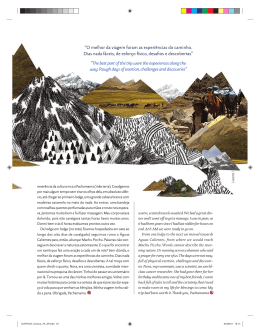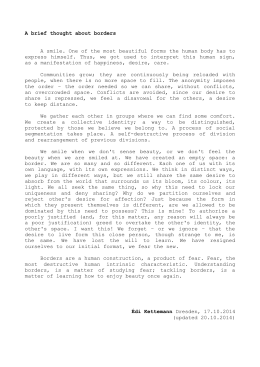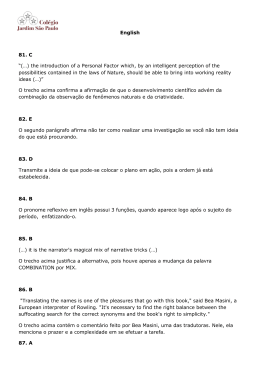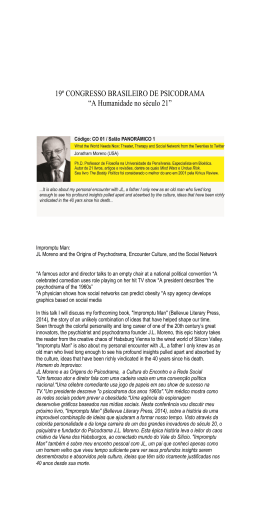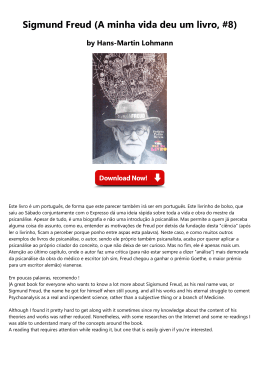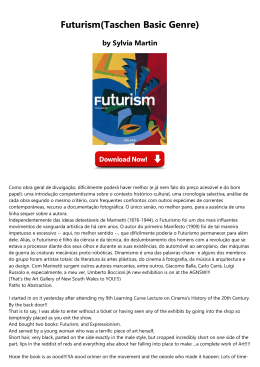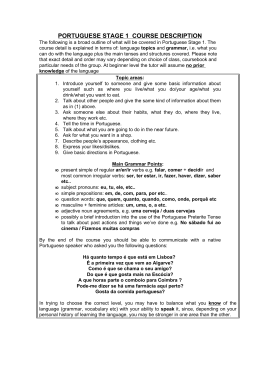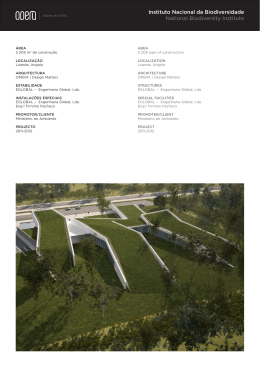Tópicos em Sintaxe I: Liudmila Nikolaeva Polysynthesis in Generative Grammar. The course is devoted to polysynthetic languages. First, I will discuss the properties that distinguish them from other languages and the problems they pose for linguistic theory. Then, I’ll give an overview of the proposed solutions and the debates about them. In particular, the class will concern the universality of lexical categories, the hypothesis of pronominal arguments and its later criticism and alternative analyses. The discussion will mainly concern Salish languages, but will include material from other polysynthetic languages and data from Adyghe. Tópicos em Sintaxe II: Cilene Rodrigues Em matemática, recursividade é definida com termos de: (I) um caso e base e (II) um conjunto de regras que formulam todos os outros casos em termos do caso base (e.g. sequências de Fibonacci e a função factorial). Em linguística, a definição desse termo é uma questão candente (Cf. Bar-Hillel 1953; Chomsky 1955, 1965; 1995, entre outros). Recentemente, Hauser, Chomsky & Fitch (2002) trouxe essa discusão ‘a tona ao argumentar que a recursividade: 1. É a única propriedade que define a faculdade inata de linguagem (componente computacional – linguagem restrita); 2. É a único traco humano da linguagem; 3. É uma propriedade particular da faculdade de linguagem; 4. É universal; 5. É encontrada apenas na mente humana. Esses itens têm sido motivo de grande debate na literatura recente. Principalmente os itens (i), (iii) e (iv). Jackendoff & Pinker (2005), por exemplo, argumentam que a faculdade de linguagem contém muito mais que recursividade (contra (i)) e que outras habilidades cognitivas tais como conhecimento de matemática e de relações socials (relacões de parentesco, por exemplo) são recursivas contra (iii)). Everett (2009), com base em seus estudos sobre a língua Pirahã, defende que o itens (iii) e (iv) são falsos. A recursividade não é uma propriedade apenas da linguagem e, não é universal. Central a esse debate é a definição do termo recursividade. Hauser, Chomsky & Fitch (2002) não oferecem uma definição do termo, mas é preciso entender de maneira crítica quais são as possíveis definições para que se possa apreciar o debate em questão. Nesse curso, começaremos com uma investigação sobre as definições de recursividade em diferentes áreas do conhecimento. Passaremos depois a uma leitura dos textos clássicos dentro linguística. Nessa parte do curso, investigaremos se a recursividade é específica do compomente sintático (entendido como o componente computacional) ou se pode estar presente em outros components. Por exemplo, é possível entender 1 operações da morfologia e da fonologia como sendo recursivas (Lander & Letuchiy 2010; Hunyadi, 2010)? Não só. É possível ter uma sintaxe desprovida de recursividade fazendo interface com componentes recursivos, como quer Culicover & Jakenfoff (1999)) para a interface sintaxe-semântica? Por ultimo, faremos também uma incursão por outros módulos do sistema coginitvo com o objetivo de verificar a validade do item (ii) de Hauser, Chomsky & Fitch. Analisaremos uma possível relação entre recursividade e teoria da mente (de Villiers 2009, Zimmer & Varley 2010) Esse será um curso dinâmico em que os alunos serão chamados a participar de maneira ativa com apresentações de textos. No final do curso, os alunos serão avaliados com base na elaboração de uma revisão (review) de um texto sobre o tema em questão. Essa revisão deverá ter de 1200 a 1500 palavras. Os alunos interessados devem entrar em contato com o professor previamente para terem acesso atencipado ás leituras obrigatórias. Tópicos em Fonologia I: Nina Topintzi Onsets – Suprasegmental and Prosodic Behaviour Onsets, the consonant(s) preceding the vowel in a syllable, are typically inert with respect to various phenomena, such as stress or gemination. As a result, most of phonological theory ascribes them no role in suprasegmental phonology. In this course, we will discuss various cases that challenge this idea and show that onsets /can/ and /do/ play a role in suprasegmental processes. Drawing on data from several languages (including Amazonian ones) and from numerous phenomena (stress, gemination, word minimality, compensatory lengthening, etc.), we will argue that a syllable-weight model that takes onsets into account is more accurate empirically and thus theoretically preferable. We will also provide formal analyses for the data at hand using Optimality Theory (OT). The course presupposes some prior knowledge of phonology and a basic understanding of the workings of OT (Prince and Smolensky 1993/2004). It will be of interest to students of phonology, typology and Optimality Theory. Tópicos em Fonologia II: Andrew Nevins Vowel Reduction and Consonant Lenition: Two sides of the same coin. This course will contrast two approaches to consonant lenition. The first, espoused by Kirchner (1998) and Lavoie (2001), is that weakening of consonants (e.g. from stops to fricatives, flapping, complete debuccalization) reflects a kind of articulatory optimization: a grammaticalization of economy of effort that allows speakers to economize on the difficulties of speech production where possible. The second, less popular, but arguably more accurate view, is the one proposed by Harris (2003) and Kingston (2008), is that lenition is motivated by a desire to highlight foot structure for the behalf of the listener, and thus has as its goal the purpose of restricting the distribution of allophones so as to maximize the differences between foot-internal and foot-edge positions. In effect, lenition and fortition are alternate ways of marking prosodic constituents and other relevant boundaries so as to facilitate parsing for 2 the listener. This course will offer empirical arguments for the latter view, based on a wide variety of crosslinguistic evidence. Most importantly, it will then turn to an analysis of vowel reduction, a set of processes often treated completely distinctly from those of consonant lenition (although the medieval Arab grammarians recognized their parallel nature), and argue that both vowel reduction and consonant lenition are implementations of ‘information loss’ in weak prosodic positions. Tópicos em Semântica I: Raj Singh Description: This class will focus on current debates between classical, pragmatic theories of scalar implicature and recently developed grammatical approaches. We will focus on data that might help decide between choice points that naturally get raised in the different approaches, such as the nature of the alternatives that enter into implicature reasoning, the difference between scalar implicatures and ignorance inferences, the information that the reasoning is sensitive to (context-dependence and context-blindness), competing statements of maxims, of cancellation and the role of relevance, and evidence for and against so-called ‘embedded implicatures.’ We will also look at psycholinguistic evidence, including reaction time and acquisition data, in helping to adjudicate the debate. Throughout the course we will try to draw broader lessons concerning the organization of language and mind. What are the predictions the theories are committed to concerning the essence of the linguistic system (i.e., Universal Grammar), the pragmatic system, and their interaction? What is the task for the child under the competing theories? Once the relevant capacities are acquired, how, under the competing theories, are they put to use? The course will be fairly self-contained. Students should have familiarity with the basic concepts of propositional and first-order logic, or a first-course in natural language semantics, pragmatics, or advanced philosophy of language. Knowledge of syntax would be useful, but isn’t necessary. We will provide a very short introduction to the basics of scalar implicature, but will move very quickly to advanced questions and methods at the edge of current research. Tópicos em Semântica II: Suzi Lima The count-mass distinction cross-linguistically: semantic and experimental aspects. (A distinção contável-massivo através das línguas: aspectos semânticos e experimentais) Linguists and philosophers have long been fascinated with the count-mass distinction (e.g., Quine (1960), Burge (1972, 1975), Pelletier (1975), Bunt (1979), Parsons (1970), Link (1983), Bunt (1985), Chierchia (1998a, 1998b), Borer (2005), Schwarzschild (2006), among many others). Across many languages, count and mass nouns possess distinct morphological and syntactic properties. The literature on this topic has established three different categories of languages: number-marking languages, classifier languages and number-neutral languages. 3 In the last few years, advances have been made both in theoretical formal semantics (Chierchia 2010, Rothstein 2010, Schwarzschild 2011, among others) and in the description of understudied languages, until then severely under-represented in the literature on the countmass distinction (cf. Wilhelm 2008 on an analysis for Dene Suliné, and Dalrymple & Mofu (to appear), for an analysis for Indonesian, among others). Moreover, psychosemantics experiments further contributed to the development of the theory of countability (Barner and Snedeker 2005, Inagaki & Barner 2009, among others). This course will explore the most recent proposals on the count-mass distinction and the experimental work that has been done to explore this topic and related issues. We will have a ‘lab’ day to discuss useful methodologies on this topic to work on under-studied languages based on my own research on Tupi languages (Yudja, Kawaiwete). Familiarity with basic logic and/or formal semantics will be assumed. This class may be taught in Portuguese or English, according to the public enrolled. Morfofonologia computacional e experimental: Michael Becker Speaking a language means knowing the real words of the language (e.g. lea[f] lea[v]es but chie[f] chie[f]s) and also having hypotheses about words we’ve never heard before (what is the plural of "crea[f]"?). In this class, we will study several cases of irregular patterns, and learn how to treat them empirically and theoretically. On the empirical side, we will learn how to study morpho-phonological trends in the lexicon, how to create novel words, present them to speakers, and analyze the results. On the theory side, we will introduce an approach that uses the principles of generative linguistics to learn trends in the lexicon and model how humans learn them. Psicolinguística: Florian Jaeger Since the dawn of modern linguistics, the question whether the structural properties of language are to a large extent reducible to general cognitive limitations, general learning biases, and/or general pressures for communicative suitability has been at the center of many heated debates (cf. functional – vs. generative linguistics). The search for non-arbitrary principles that aren’t specific to linguistic representation and processing is intriguing as it holds the promise for a parsimonious account of linguistic structure (i.e. it might help to reduce the number of arbitrary linguistic constraints that need to be posited). However, such an approach faces two major challenges. First, in order to make strong (falsifiable) predictions, we need to know what properties of language are functionally dispreferred – that is, what makes something hard to learn, to understand or to speak? This class provides a summary of the last decades of psycholinguistic research, with a focus on recent findings. This includes insights from so called computational psycholinguistics, which employs information theory and Bayesian models. Second, the functionalist approach is doomed to fail unless it is possible to identify how the hypothesized general biases affect linguistic representations. In other words, if functional pressures are to explain typological universals, functional pressures somehow 4 need to be able to cause (possible subtle) changes to a language (possibly over long periods of time). This could happen during acquisition or through biases operating during language processing. We summarize recent work that speaks to these two hypotheses. In discussing the hypothesis that functional pressures are part of the explanation why languages have the properties they have, we won’t arrive at a definitive conclusion. The goal of this class is rather to summarize some of the most recent and state-of-the-art research that bears on this question. To this end, we will also provide the necessary background on language processing. 5
Download
